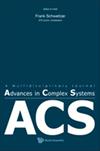单长度循环双吸引元胞自动机的下一状态规则最小项转移图表征
IF 1
4区 数学
Q4 MATHEMATICS, INTERDISCIPLINARY APPLICATIONS
引用次数: 0
摘要
元胞自动机(ca)是一种简单的数学模型,可以有效地用于分析和理解复杂系统的行为。来自广泛领域的研究人员对CAs感兴趣,因为它们具有代表各种物理、自然和现实世界现象的潜力。三邻域一维ca是一类特殊的ca,在VLSI设计、纠错码、测试模式生成、密码学等领域有着广泛的应用。本文对具有两种状态的三邻域元胞自动机(CA)进行了深入分析。提出了一种基于图的下一状态规则短时转移图(NSRTD)工具,用于分析具有不动点的ca的状态转移行为。本文提出了一种线性时间机制来合成一类特殊的不可逆CAs,即只有两个不动点的单长周期双吸引子CAs (TACAs)。本文章由计算机程序翻译,如有差异,请以英文原文为准。
Characterization of Single Length Cycle Two-Attractor Cellular Automata Using Next-State Rule Minterm Transition Diagram
Cellular automata (CAs) are simple mathematical models that are effectively being used to analyze and understand the behavior of complex systems. Researchers from a wide range of fields are interested in CAs due to their potential for representing a variety of physical, natural and real-world phenomena. Three-neighborhood one-dimensional CAs, a special class of CAs, have been utilized to develop various applications in the field of very large-scale integration (VLSI) design, error-correcting codes, test pattern generation, cryptography and others. A thorough analysis of a three-neighborhood cellular automaton (CA) with two states per cell is presented in this paper. A graph-based tool called the next-state rule minterm transition diagram (NSRTD) is presented for analyzing the state transition behavior of CAs with fixed points. A linear time mechanism has been proposed for synthesizing a special class of irreversible CAs referred to as single length cycle two-attractor CAs (TACAs), having only two fixed points.
求助全文
通过发布文献求助,成功后即可免费获取论文全文。
去求助
来源期刊

Advances in Complex Systems
综合性期刊-数学跨学科应用
CiteScore
1.40
自引率
0.00%
发文量
121
审稿时长
6-12 weeks
期刊介绍:
Advances in Complex Systems aims to provide a unique medium of communication for multidisciplinary approaches, either empirical or theoretical, to the study of complex systems. The latter are seen as systems comprised of multiple interacting components, or agents. Nonlinear feedback processes, stochastic influences, specific conditions for the supply of energy, matter, or information may lead to the emergence of new system qualities on the macroscopic scale that cannot be reduced to the dynamics of the agents. Quantitative approaches to the dynamics of complex systems have to consider a broad range of concepts, from analytical tools, statistical methods and computer simulations to distributed problem solving, learning and adaptation. This is an interdisciplinary enterprise.
 求助内容:
求助内容: 应助结果提醒方式:
应助结果提醒方式:


